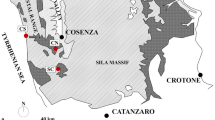Abstract
The open porosity of a specimen of stone or brick material is often measured using a gravimetric method based on Archimedes’ principle. This widely used technique also allows both the bulk density and the solid density of the specimen to be determined, although the solid density is not often reported. We discuss the relation between the porosity and density, both for single specimens and for groups of specimens of similar materials, using for illustration data on limestones, sandstones and fired-clay bricks. The significance of the solid density can be overlooked but it is informative both as a material property and as a method of identifying errors in data. We emphasize how the solid density depends on mineralogy and on closed porosity.





Similar content being viewed by others
References
Purdy RC, Moore JK (1907) Pyro-chemical and physical properties of clays. Trans Am Ceram Soc 9:204–318
Hall C, Hoff WD and Prout W (1992) Sorptivity–porosity relations in clay brick ceramic. Am Ceram Soc Bull 71:1112–1116
Hall C (1996) Clay brick. In: Jackson N, Dhir RK (Eds) Civil engineering materials, 5th edn. Palgrave, Basingstoke
Hall C, Hoff WD (2012) Water transport in brick, stone and concrete, 2nd edn. Taylor and Francis, London
BS EN 1936:2006 Natural stone test methods determination of real density and apparent density, and of total and open porosity
Sitepu H (2009) Texture and structural refinement using neutron diffraction data from molybdite (MoO3) and calcite (CaCO3) powders and a Ni-rich Ni50.7Ti49.30 alloy. Powder Diffr 24:315–326
Honeyborne DB (1982) The building limestones of France. HMSO, London
Fronteau G, Schneider-Thomachot C, Chopin E, Barbin V, Mouze D, Pascal A (2010) Black-crust growth and interaction with underlying limestone microfacies. In Prikryl R, Torok A (eds) Natural stone resources for historical monuments, Geological Society Special Publication, London 333:25–34
http://projects.bre.co.uk/ConDiv/stonelist/stonelist.html. Accessed 16 Dec 2013
Ross KD, Butlin RN (1989) Durability tests for building stone, Building Research Establishment Report 141, BRE, Watford, UK
Hurst VJ, Storch SP (1981) Regional variation in the cell dimensions of metamorphic quartz. Am Min 66:204–212
Davis DH (1954) Estimating the porosity of sedimentary rocks from bulk density. J Geol 62:102–107
Dunham AC (1992) Developments in industrial mineralogy: I. The mineralogy of brick-making. Proc Yorkshire Geol Soc 49:95–104
Dunham AC, McKnight AS, Warren I (2001) Mineral assemblages formed in Oxford Clay fired under different time–temperature conditions with reference to brick manufacture. Proc Yorkshire Geol Soc 53:221–230
Prout W (1989) Studies of frost damage in masonry, PhD Thesis, Manchester
Griffin IG, Hall C, Hamilton A (2013) Unusual water-transport properties of some traditional Scottish shale bricks. Mat Struct. doi:10.1617/s11527-013-0149-7
Raimondo M, Dondi M, Gardini D, Guarini G, Mazzanti F (2009) Predicting the initial rate of water absorption in clay bricks. Constr Build Mater 23:2623–2630
ASTM C373 (1994) Standard test method for water absorption, bulk density, apparent porosity, and apparent specific gravity of fired whiteware products
ASTM C329 (1994) Standard test method for specific gravity of fired ceramic whiteware materials
Hamilton A, Hall C (2013) Mechanics of moisture-expansion cracking in fired-clay ceramics. J Phys D 46:092003
Roels S, Carmeliet J, Hens H, Adan O, Brocken H, Cerny R, Pavlik Z, Hall C, Kumaran K, Pel L, Plagge R (2004) Interlaboratory comparison of hygric properties of porous building materials. J Thermal Envel Build Sci 27:307–325
Lamb H (1928) Statics, including hydrostatics and the elements of the theory of elasticity, 3rd edn. Cambridge University Press, Cambridge
Courant R, John F (1974) Introduction to calculus and analysis, vol 2. Wiley, New York
Lima FMS (2012) Using surface integrals for checking Archimedes’ law of buoyancy. Eur J Phys 33:101–113
Acknowledgments
We thank Maurice Rogers for drawing our attention to the data contained in the BRE stone list, and for useful discussions on British sandstones; Tim Yates (BRE) for providing new data on Ancaster limestone and information on test procedures; and Vicky Pugsley and Isobel Griffin for unpublished data.
Author information
Authors and Affiliations
Corresponding author
Appendix: Archimedes buoyancy
Appendix: Archimedes buoyancy
For a regular, non-porous solid specimen of uniform density, the hydrostatics of the Archimedes weight is simple (for example [22]) but for the rarer case of an irregular specimen of arbitrary shape, Gauss’s divergence theorem can be used to relate the hydrostatic pressure acting on the immersed surface of the specimen to its volume [23, 24]. This analysis applies without modification to a porous material provided that the liquid completely fills the open porosity and is in hydrostatic equilibrium throughout. Any closed porosity is treated as part of the solid material. The distribution of density in the specimen does not enter the analysis as the Archimedes weight depends only on the buoyancy force (which depends on the specimen volume) and on the specimen mass.
The requirement that the liquid is in hydrostatic equilibrium throughout the pore space is important, but for most materials of interest pressure diffusion in a laboratory size specimen is rapid. The timescale for pressure to diffuse a distance L is τ = L 2/c, where c is the diffusivity. For brick and stone materials c = 4 × 10−4 k w G where k w is the water permeability of the specimen and G its shear modulus, so that τ is generally a matter of seconds.
Rights and permissions
About this article
Cite this article
Hall, C., Hamilton, A. Porosity–density relations in stone and brick materials. Mater Struct 48, 1265–1271 (2015). https://doi.org/10.1617/s11527-013-0231-1
Received:
Accepted:
Published:
Issue Date:
DOI: https://doi.org/10.1617/s11527-013-0231-1




